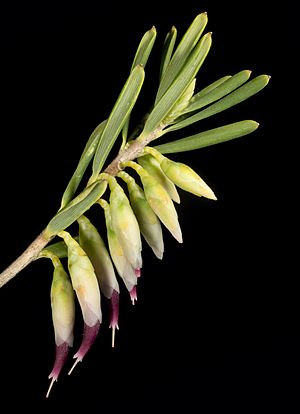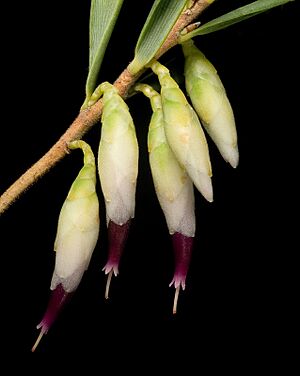Conostephium minus facts for kids
Quick facts for kids Conostephium minus |
|
|---|---|
 |
|
| Scientific classification | |
| Synonyms | |
|
Conostephiopsis minor Stschegl. |
The Conostephium minus, often called the pink-tipped pearl flower, is a type of shrub. It belongs to the Ericaceae plant family, which also includes plants like blueberries and heather. This special plant grows only in Western Australia.
What it Looks Like
The pink-tipped pearl flower is a small to medium-sized shrub. It can grow from about 15 centimeters (about 6 inches) to 75 centimeters (about 2.5 feet) tall.
Its flowers have a unique look. The part of the flower called the corolla tube is purple where you can see it. Inside, the tiny hairs on the top half of the ovary (which holds the seeds) are fuzzy.
Scientists can tell Conostephium minus apart from a similar plant, Conostephium magnum, by measuring different parts of their flowers. For example, the longest sepals (leaf-like parts under the petals) are between 5.6 to 7.2 millimeters long on Conostephium minus.
How it Got its Name
The Conostephium minus was first described and given its scientific name by a botanist named John Lindley. He did this in 1839 in a book called A Sketch of the Vegetation of the Swan River Colony.
The second part of its scientific name, minus, is a Latin word. It means "small." This probably refers to some of its smaller features compared to other plants.
Where it Lives
This shrub is found in specific areas of Western Australia. It grows on gently rolling sandy plains. The sand can be white, grey, or yellow. These areas are part of what is known as Beard's South-West Province.


